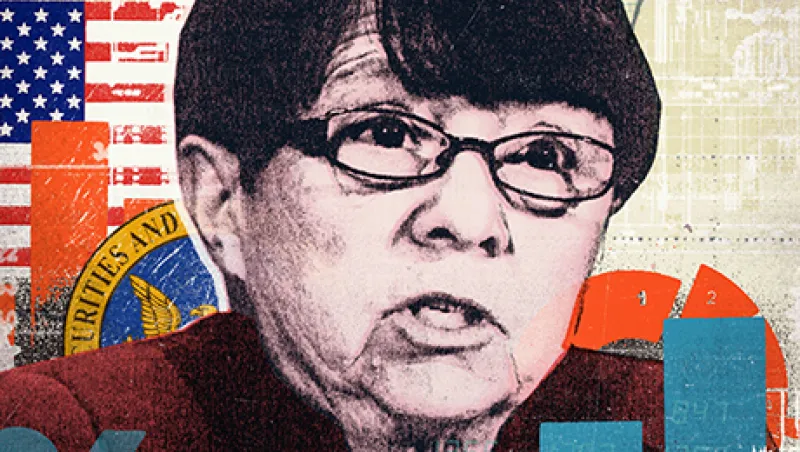In his recent book Flash Boys: A Wall Street Revolt, author Michael Lewis grabbed the public’s attention with a simple yet powerful statement: The market is rigged. Chief U.S. financial regulator Mary Jo White disagrees. During the recent Sandler O’Neill + Partners Global Exchange and Brokerage Conference in New York, the Securities and Exchange Commission chair told the crowd that “the current market structure is not fundamentally broken, let alone rigged.” Still, there’s room for improvement. On the heels of Lewis’s book, the SEC and other regulatory bodies aim to give market structure a thorough inspection, and so-called dark pools are high on their list.
White’s address highlighted concerns such as market instability and fragmentation, and conflicts of interest regarding brokers’ best execution practices. High frequency trading, the primary villain of Flash Boys, got an airing too. Inextricably linked to HFT strategies are alternative trading systems, or ATSs. These off-exchange electronic venues include dark pools, where trades take place outside the purview of the general market, shielding buyer and seller from onlookers — and making true price discovery that much tougher.
Early dark pools — Investment Technology Group’s POSIT, launched in 1987, was among the first — were used mostly by large institutional investors to move block-size trades without leaking potentially market-moving information to the many brokers needed to execute them, or to help move illiquid securities.
This started to change when banks moved from an agency to a principal model, says Larry Tabb, the Westborough, Massachusetts–based founder of financial research and advisory firm Tabb Group. “Spreads declined, and it became tougher for the banks to profit in owning these stocks and trading out of them on a principal basis,” Tabb explains. Also, the rise of algorithmic trading spelled the end of large-scale block trades, in a sense, by slicing and dicing orders. “As more blocks get broken into pieces, there’s less natural liquidity on the other side to trade with, so it becomes a self-fulfilling prophecy.”
Today there are about 40 dark pools that handle some 15 percent of U.S. trading volume. The biggest include platforms operated by European banks Barclays, Credit Suisse Group and UBS, with Credit Suisse’s Crossfinder accounting for the most shares traded, according to the Washington-based Financial Industry Regulatory Authority.
In her speech White took note of dark pools’ opacity. She wants more information made public through disclosure of these exchanges’ Form ATSs, which keep the regulator apprised of their activities and operations. Several, including Crossfinder, Goldman Sachs Group’s Sigma X and IEX, co-founded by Flash Boys protagonist Brad Katsuyama, have done so voluntarily.
So has New York–based ITG. Head of electronic brokerage and sales Jamie Selway found little to quibble with in White’s talk, and he didn’t see much of a direct indictment of dark pools as a market disrupter. ITG still operates in the “canonical dark pool” structure, with blocks trading at the midpoint, Selway says. The term “dark pool” has become a catch-all, he notes, with bulge-bracket firms coopting it in the mid-2000s as part of their shift toward internalizing order flow.
With Regulation NMS, the SEC may have inadvertently worsened its fragmentation problem, says Justin Schack, head of the market structure analysis group at Rosenblatt Securities, a New York–based institutional agency brokerage. The 2007 rule was intended to ensure that customers get the best possible prices on their trades by, among other practices, improving access to displayed quotes. This created “some incentives for more exchanges to exist, more dark pools to exist, and the market got faster and more automated,” says Schack, who adds that one result was more complexity. “Now institutional investors see their orders going to many, many destinations, and they need a way to monitor all that because there’s a big conflict of interest baked into the complexity of our market structure.”
The maker-taker model, whereby providers of liquidity to a trading venue receive rebates while those taking it are charged a fee, was called into question at a June hearing held by the U.S. Senate. The problem: Brokers may see an incentive to route orders to the cheapest venue rather than the one most beneficial to the client.
It’s hard to show that a broker isn’t acting in a client’s best interest, says Tabb Group’s Tabb, pointing out that the venues with the largest rebates tend to have the most liquidity. “That said, it’s going to be the most expensive place to trade, and so there’s more incentives to try to take liquidity from places that are cheaper first.” But an investor may end up going to between 20 and 30 dark pools before finding one with enough liquidity, Tabb estimates.
For ITG’s Selway, price discovery isn’t a big concern. “I appreciate that argument at the limit, that if everything traded on dark and nothing on lit, prices would get screwy,” he says. But if they do get out of hand, arbitrage will set them right, Selway asserts.
SEC chair White suggested mandating more disclosure of order routing by ATSs for institutional clients. From a regulatory standpoint, looking out for investors is paramount. Confidence in the markets hasn’t been lost, White said, pointing out that executing large orders is cheaper for institutional investors now than in 2006. Likewise, bid-ask spreads are narrower than ever, reflecting trading at best prices for retail investors.
Although regulators may not like it, opacity is inherent to dark pools’ function: Investors use them to keep a lid on trading strategies. Because these venues don’t disclose price quotes publicly, they’re naturally tougher to fathom. For Rosenblatt’s Schack, the main public policy question is whether the market is “doing the best possible job of arriving at the best price of a security.”
White also recommended establishing an expert Market Structure Advisory committee to extend the conversation on the broader issue of market complexity and “serve as an additional forum and resource for reviewing specific, clearly articulated initiatives or viewpoints.” ITG’s Selway agrees with the SEC push for better data, empirical research and analysis, but he downplays worries about market structure: “I view this dark-pool-versus-lit [debate] as the same tension [as] between passive and active management.”
Get more on trading and technology.






